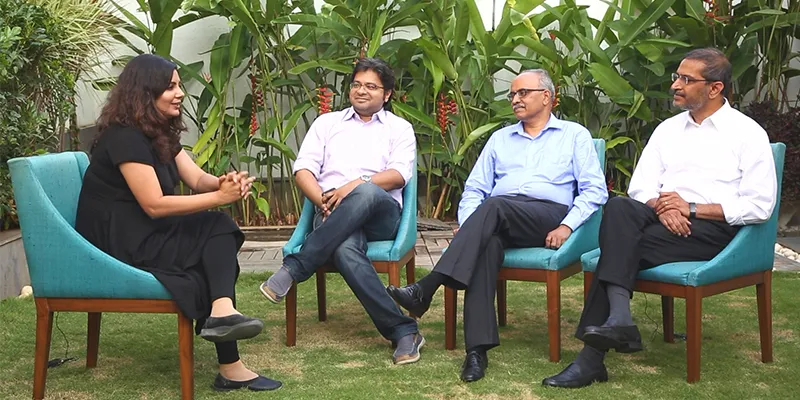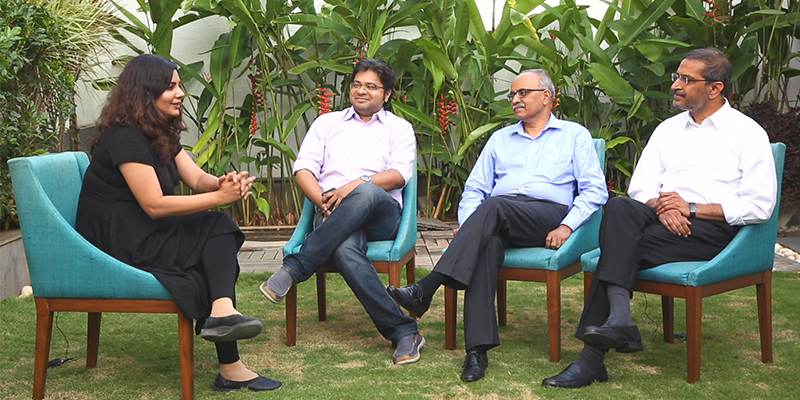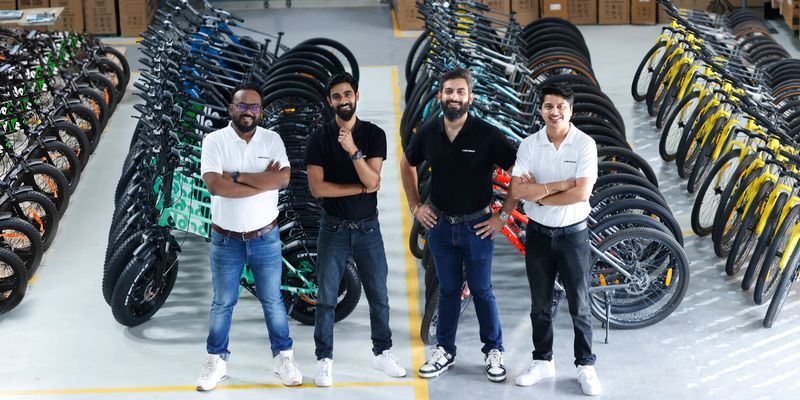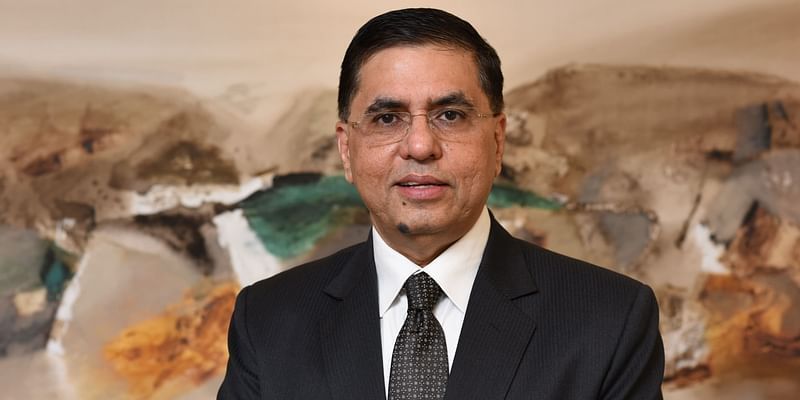No me-too startups for Endiya Partners - Endiya continues to invest in early-stage Deep Tech Startups to boost India’s Innovation Story in 2018
I caught up with the partners of the venture capital fund, Endiya Partners recently to discover, among other things, their plans for 2018, their take on the exits scenario in India, how entrepreneurs can approach them, and how they take challenges head-on. My takeaway was that their focus on early-stage startups, a realistic assessment of returns on investment and partners whose experience spans engineering, product management, entrepreneurship and, believe it or not – medicine – they appear uniquely positioned to leverage innovative ideas and help them scale.
And, yes, what remained on top of my mind through this interview was, here are some genuinely good people trying to give back to the Indian startup ecosystem and are investors you could count on during tough times.
Shradha Sharma: Sateesh, tell me about Endiya Partners.
Sateesh Andra: Endiya is currently a two-year-old fund of approximately Rs 200 crore. Our focus is on Seed and Pre-Series A stages and deep-tech startups. We look at three themes: The first is Indian product startups serving Indian markets and also targeting regional markets whether it’s Southeast Asia or the Middle East. The second set of startups are based in India but they are going after global opportunities - the US or Europe. Tough task but nevertheless some of these entrepreneurs are fearless and know what they are doing, and they want support from investors who understand their journey. The third theme (we’ve seen a little bit of activity in that, but we anticipate we’ll see more and more of it) are the global startups that are headquartered in Silicon Valley or Europe, targeting emerging markets first.
In terms of sectors, we’re primarily focused on SaaS, Security, Mobility, Semiconductors, Fintech, Digital health and Medical devices. Dr Ramesh who is my partner, Abhishek, and I came together, and our calling was to support these product startups.
We believe early-stage is where they really need a kind of ‘co-founder-VC’, who can help companies figure out Product-Market fit, sign up first set of pilot customers and hire right talent so that they get ready to go the next level
Endiya implies enabling the Diya (the light). It also means India on a Global Platform.
A few things that differentiate us are that we go in very early, we’re very stage and sector-focused so we’re not all things to all people. For example, if we don’t understand a domain, we would not invest in it because we would not be able to add value. So, it’s not a ‘spray and pray’ approach.
Second, a product is a must, and third, a certain amount of global relevance is required. Fourth, we have a deep engagement model. However, that doesn’t mean that we drive the car from the backseat – we don't intend to! It’s the entrepreneurs who drive, and we have always been saying this on record that entrepreneurs build the companies and not the venture capitalists.
A venture capitalist is, at best, a catalyst or a coach and partakes in the journey with the entrepreneurs. The deep engagement model arises from the fact that we have entrepreneurial, operating and domain experience,” So the most important thing for us is to understand the product and service of our portfolio company, their customer requirements, and then the competition. When you really look at the confluence of these three, then you are able to add value to these companies.

Shradha: One thing which stands out about this fund is that you have a (medical) doctor on board. I have been tracking this space for the last nine years and I have never heard of a doctor who is a venture capitalist. Here, you are, at the front, investing in companies. How did you become a venture capitalist and are you still a practising doctor?
Dr. Ramesh Byrapaneni (Managing Director, Endiya Partners): I am a Cardiologist. I studied in PGI Chandigarh, went to the US, did my Interventional Cardiology Fellowship. I have practised medicine for 25 years, including my training. So, what happens as a doctor, whether you’ve just started your practice or 10 years later, or even 25 years later, you still see the same 30-40 patients a day. I thought this was stagnation. You have only one life and I felt I had to make a deeper impact. I wondered, can I be a part of history, bringing a new medicine into the global market or a medical device which completely changes the world? The idea of continuing to practice medicine, doing angioplasty, and doing the same work day after day… became a little boring.
I wanted to make a deep impact with the knowledge I gained over the last 25 years as a doctor who interacted with millions of patients. I knew the pain points and thought that I can be of value and help some entrepreneurs in their journey. That became my calling – that’s why I quit practice and became a full-time investor to support start-ups in the country.
Shradha: Abhishek, how did you become a part of this story, the Endiya story?
Abhishek Srivastava (Director, Endiya Partners): In my career span of 15+ years, I have worked in Operating, Consulting and Engineering roles. Am an Engineer by background, started my career building enterprise products. Post my MBA from ISB (Hyderabad), switched careers, moved to consulting and investment banking with Deloitte and PricewaterhouseCoopers before joining Corp Dev & New Business Development team at Cyient. Subsequently, I got to know Sateesh.
Interestingly, it all happened under a forum of TiE. That’s when Sateesh and I started an initiative called “TiE Buddies” where we used to teach school children about entrepreneurship. That’s where we got to know each other and the aspirations aligned.
With all the right ingredients in place and the timing is perfect, I believe India is ready to build and produce world-class software companies. Having spent time in building and implementing strategies and products for companies, I was very excited in the idea of partnering with entrepreneurs in the early stages of business building and came on-board with Sateesh and Dr Ramesh.
On exits in India
Shradha: Globally, there is this whole question mark that the money invested in India has not given good returns. What do you have to say about that, Sateesh?
Sateesh Andra: Obviously all Startup Ecosystems need full cycles. The LP is giving money to the GPs and GPs (are) deploying that capital in startups, and they are really building value in terms of product and service that’s accepted in the market, getting a meaningful exit, returning that money into the funds and funds, in turn, returning it (to invest further).
In India, there are a few funds who have had good cycles and created good returns. Investors, whether they are Endowments or Pension funds, or Family offices or Fund of Funds only, are aware that venture capital is the riskiest asset class. So, only a small portion of their money goes to the venture capital asset class. I think the LPs are also very patient and there is a reason why they invest in the venture capital asset class. In addition to the returns (30 percent IRR or 40 percent IRR), they also want to invest in startups that eventually make the world a better place to live in.
I think time will tell in the next five-six-seven-years and I am pretty sure there will be a clear verdict in terms of who is going to be here and who is going to wind up gracefully and then move on.
Shradha: Do you feel that the "India Story" is there but is just taking a little longer, especially because of the enabling infrastructure? We have e-commerce but the infrastructure around it has taken time to build…
Sateesh Andra: The enabling infrastructure is relevant to the entire startup ecosystem, I think what’s very important is that exits fuel the ecosystem. If you look at corporates like Google, Cisco, Amazon, Apple, Intel paying the amount of money they are paying to all the startups, 50-60 percent of M&As is done by these four or five large tech companies in the Valley.
The reason why they write such big cheques is that they themselves got that market capitalization due to their speed and market leadership. It’s not that they built this over a hundred years. So, they understand the value of innovation and time to market and hence they know when they bring in something and how big they can become.
Cisco at one point in time, in the late 90s, bought, four companies, and paid $600 million for these acquisitions. We were all asking, "Is Cisco nuts"? Cisco in one year made $2 billion with just these four companies. They have created sales worth of $2 billion with these acquisitions so they acquired them, digested them and put them back into their channels.
The biggest challenge in India today is Exits. None of the potential buyers with deep pockets has the mindset of speed or market ownership. On the contrary, they say that they will do everything on their own even if it takes 10 years or 15 years – that’s one big challenge.
In the Indian context, RedBus, FreeCharge, or TaxiForSure - I think they are very lucky honestly and that’s because they’ve exited at the right time and received a decent valuation.
When Myntra received a decent valuation, the employees and investors were happy, and I think that’s fantastic for the ecosystem. Only when you see many of these happening and producing real value, even for the acquirer, will this eco-system go to the next level.
The other issue is that our markets are really small! Unless you get to other adjacencies and regional markets, you really can’t build $100 million in revenue. I am not talking about the GMVs and overall transaction (but) the real revenue so that you can keep $10 -$20 million in net profit. You can't get to that scale. I see positive signs but still, I think it will take a certain amount of time. Only when that happens, I think real exits and real returns will happen.
Otherwise, this is all going to be secondary sales and sometimes if you've done disruptive technology, some large tech company will come and buy either as an ‘acqui-hire’ or buy the product.
Dr Ramesh Byrapaneni: Another challenge, especially with regard to healthcare is that it takes far longer than any other sector… for a couple of reasons.
For any medical product, whether it’s pharma or biotech or medical device or even for digital health, you need to get the regulatory approvals and they have their own timelines.
Additionally, for biotech, pharma, and medical device companies, you need to do clinical trials and get the regulatory approvals even before you could market or sell. Real value-addition in a company happens actually after the tenth, fifteenth, or even twentieth year. That could be an additional challenge, especially for startups in the life sciences sector.
Endiya Partners’ investment outlook for 2018
Shradha: At Endiya, what’s the plan for 2018, because we've not seen that many early-stage investments in the market, right?
Sateesh: It’s been an active 2017 and I think 2018 is also going to be a very active investment year for us. During our informal conversations, I mentioned that majority of these folks as Darwinbox, Hansel.io, Kissht, InnerChef… all of them have raised follow-up rounds of capital.
In the first half of 2018, we plan to make another four to five new investments. I think next year is when we would also sit together to think what our future is going to be like.
And one of the things we said, Shradha, was it’s not going to be a spray and pray approach. We will do seed investments, our pro rata in all of Series A and if possible, even Series B, which means we want to make only a certain number of bets and reserve capital for them, and we have done that.
In most of our companies, we have invested in Series A rounds, either a pro-rata or a super pro-rata. So, a portfolio of 15-16 companies’ allocation of anywhere around between Rs 10 and Rs 15 crore per company is the strategy.
Shradha: So, from an exits perspective are you looking at a 10-year cycle?
Sateesh: I think even in tech outside of even healthcare, it takes two years to find the product-market fit. Once you get to the product-market fit, acceleration happens in the 3rd, 4th and 5th years.
Once the momentum is built, it all depends on the entrepreneur. If the entrepreneurs say somebody wants to stop my journey, and there is a good reason for me to stop my journey, and if they get excited, then that results in an exit.
But if they want to go all the way and contemplate Series B or Series C fundraise, it's their call. For entrepreneurs, that one company is the only thing they have, but for a VC it’s a portfolio game and even if two or three of them do well, we can show the returns may say we did a good job!
This is unlike that entrepreneur who has spent eight, ten, twelve years in that one single company
I think in the end they need to make decisions, that are sometimes tricky."
You may not get your 20x return, you may only get 4x or 6x returns, but it’s still that entrepreneur’s decision that is more important than the VC's decision.
Shradha: You already have all the mark-ups on your investments. We would like investors like you to be investing a lot more and have a large corpus. Are you going to increase it?
Sateesh: Coming to the large corpus, there are two things: our calling and why we get excited. I think you can independently talk to some of our entrepreneurs to hear what they say about us.
So, one of the things we said is that we are going to go in like the co-founder VC, help them in the product roadmap and then the business model, pilot customers, and partners. We are on the calls – analysts’ call with Gartner’s and others, we've done that! Abhishek has been on several calls with Gartner’s or Forrester’s along with the portfolio companies.
So, we'll stick to our thesis of Pre-Series A and do Series A. The second thing I see is whether I am able to return 3x the investment in the fund. So if it’s a $100 million fund, that’s $300 million of returns to our LPs. So, if my ownership is roughly 20 percent, it’s not going to be more than that because there will be multiple investors in a startup. It’s going to be more in the 15-20 percent range. So, 20 percent of my ownership has to result in $300 million, actually, that means I need to have to have portfolio exits of $1.5 billion, for a $100 million fund.
In practice what will happen, only time will tell.
We're not going to be a very large fund. I think to be a Rs 500 crore fund is the right size fund for India. Then you can allocate around Rs 20 crore per company, and you can have a portfolio of about 18-20 companies.
Shradha: And your thesis would always be to stay invested in all the companies by participation in multiple rounds…
Sateesh: Absolutely! Just like First Round Capital, they had plenty of unicorns, but have never increased their fund corpus. Founders Fund or Lower Case Capital for that matter… I think all these people are pretty much stuck with that kind of thesis. We believe that we will need $3-4 million that we can allocate per company and go to work.
There are big branded VCs that have hundreds of millions of dollars in corpus who are willing to deploy lots of dollars if our startups pass those VCs’ litmus test. Hopefully, us doing the work upfront will allow our companies to go raise follow up capital from all the great funds out there.
Facing challenges head-on
Shradha: If you had to say what’s one of the most pressing challenges in the roles that you play what would that be? What is it that sometimes keeps you awake at night?
Dr Ramesh: Many times people ask whether doing an angioplasty is more stressful than (making an) investment. To me, probably an angioplasty is far simpler than making a decision to invest !!
You're betting your 30-40 years of knowledge onto an idea that will take off. To me what is the most stressful is the bet you are making, as to whether that is the right bet or not and we do a lot of due diligence.
It’s not day-to-day operations that is stressful. Things like hiring may go wrong sometimes; the regulatory approvals may go a little longer, but you continue making the right bets with your knowledge and wisdom. That’s what I think to me, is the most anxious and stressful part.
Abhishek: I wouldn’t call it stress, but every day there is a sense of excitement of making sure things are on the right track. Entrepreneurs have too many tactical and strategic things to handle and that can distract them easily. I think as an Investor, one needs to help entrepreneurs separate noises from signals and ensure that execution focus continues to be there. Having said, it’s always easier said than done.
I think it’s one of the exciting, critical and difficult challenges.
Sateesh: Saying that there is no stress is not really possible. I think there is stress, for instance, raising money at the right time is very necessary. More important is that they have to be either No. 1 or No. 2 in their category. Alignment between the investors and the entrepreneurs is important. If there is no alignment you are pulling the entrepreneur in a very different direction then that’s not good for the company, the entrepreneur, and the investor.
In a fast-paced world, it’s not about what you do - your competition may be undoing what you are doing, entirely!
Certain global or local moves, especially when we’re talking about betting on products that are going to go global… what a Facebook or Google or Amazon does, has implications then you may look incremental, you're not completely disruptive.
They have billions of dollars, bright engineers and they are the brands. So, very clearly, I think it’s at two levels. One level is the alignment level - I think we try and achieve that alignment, (but) in the end it’s an entrepreneur’s company. They will decide – others can give inputs and coach and tell them what’s going on because you have the luxury of listening to many bright entrepreneurs or talking to many people.
Hence you can share your knowledge so that they can use those insights and arrive at decisions on their own. The other stressful part is when you compare yourself to the rest of landscape and evaluate where you are at. You want to be at one or two, you want to be raising money at the right time and you've got to be making the right noises otherwise, will you be invited to the party when the party happens!
Channels of communication
Shradha: Any entrepreneur who is watching this if they want to reach out to you, what is the best way?
Abhishek: All the channels are available. First of all, our website is very much accessible, it has all the details.
Shradha: Do you guys see deals received from the website?
Abhishek: Absolutely! all of us we have a dedicated responsibility to make sure that these are followed at a very deep level. We have an internal process as well. Also, today through LinkedIn and other social channels, I think it’s become extremely easy.
Shradha: But many VCs don’t see all these things…
Dr Ramesh: All the deals that come to us either through our personal emails, website or through LinkedIn get logged on to our deal log which we review every week.
Shradha: So, you don’t miss anything…
Sateesh: So, what we do is that there is a deal analytics process internally. And look at all the deals in the deal log and classify them as the interesting, warm, hot etc.
https://youtu.be/nIbcCGbX-zM
The best way to get in touch with us is either a good reference or something like LinkedIn where you write about why you are doing what you are doing and tell us a little bit about yourself. Our process is very simple. If there is a "No”, there is a very quick "No”, but we do respond.











